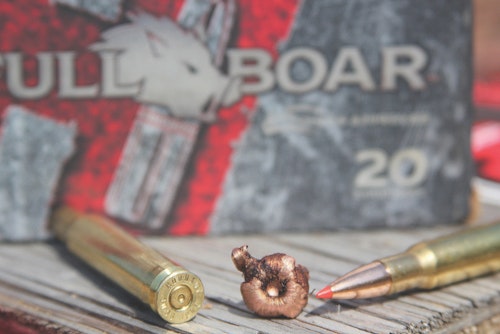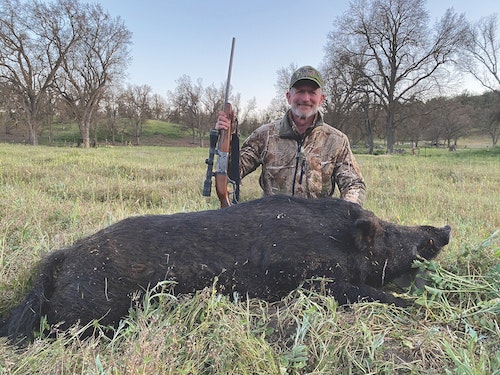The sun had just dropped below the horizon when we saw him, all alone, heading to a small alfalfa field adjacent to a brushy creek. “Here he comes,” whispered my friend Ron Gayer of Indian Rock Ranch, one of California’s most experienced and successful hog hunting guides. “Get ready.”
Using my buddy Jim Matthews’ old Savage Model 99 chambered in .358 Win. and loaded with Jim’s handloads featuring the 180-grain Barnes Tipped Triple Shock bullet, I took a solid rest; the 125-yard shot was almost a gimme. The 300-pound black boar — an exceptionally large pig for this part of the world — was the first California wild hog I’d taken in more than two decades. It was like coming home.
The popularity of wild hog hunting in America has grown exponentially over the past two decades, and why not? Guesstimates — there are no hard and fast numbers — place the current number in the United States at about 5 million piggies spread across 45 states. Populations now exist as far north as Michigan, North Dakota and Oregon; this range expansion is mostly a result of illegal translocation of pigs by humans.
Hog hunting is especially popular in the Southern tier states, led by Texas, Florida and Georgia, the top three states in terms of overall pig population. But did you know that California has the fourth largest population of wild pigs in the country? The state estimates the feral hog population is somewhere between 200,000 and 400,000 animals.

A History Lesson
As I wrote in my 1980’s book, “Hunting Wild Boar in California,” the first introduction of swine to what is now the continental United States is generally believed to have occurred in 1539, when Governor Hernando de Soto established a camp in Charlotte Harbor, Florida. de Soto brought the swine with him to feed his men and to leave behind to provision new settlements. As he continued on, de Soto’s herd of swine grew, soon becoming so large they were hard to control. In fact, as the party marched on — eventually covering some 3,100 miles and reaching parts of what are now eight additional states in the southeastern United States in three years — the herd of hogs grew to some 700 animals, with many additional hogs escaping to live on their own or being stolen by local inhabitants.
Many years later, pure-strain Eurasian wild boars were introduced into parts of the United States for hunting purposes, first in New Hampshire in 1886, then at Hooper’s Bald, North Carolina, in 1911, and again near Monterrey, California, in 1925. In areas where domestic pigs and Eurasian wild boars met in the wild, interbreeding occurred. Today, many hybrid populations exist throughout the wild pig’s range. This is what Californians hunt today.
In 1957, wild pigs officially became a game species in California, hunting regulated with annual seasons and bag limits. In 1992, wild pig tags were introduced to aid in the effective monitoring the wild pig population (and create a revenue stream for the state game department.) Currently, there are no daily bag or possession limits for hunting wild pigs, and no closed season. Regulations regarding hunting require the reporting of any successful take on a wild pig tag.
Population Fluctuations
While the wild hog population has the potential to triple every year — sows can produce two to three large litters per year — the breeding rate, and thus the current population, is highly dependent upon environmental conditions. In years of drought or large-scale agricultural and mast crop failures, breeding rates decline, and piglet survival plummets.
Omnivores that will eat just about anything, wild hogs consume everything from acorns, grasses, tubers, bulbs and forbs to invertebrates, reptiles, birds, eggs and animal carcasses. In general, they gravitate to grasses, forbs and crops such as barley, wheat, alfalfa and oats during spring and early summer, switching to mast and fruit crops during fall, while dining on roots, tubers and invertebrates throughout the year. They are incredibly destructive and currently trash many state parks and other public and private lands, as well as agricultural fields with their rooting.
As long as there is ample water and cover available, Golden State wild hogs are found in diverse habitats that include chaparral, oak woodlands, riparian, marshes and even open grasslands. They avoid steep, high mountains and deserts and areas with little cover. When hunted little, wild hogs can be seen moving about during daylight hours, though daytime activity levels drop when the weather gets hot. As hunting pressure increases, daytime activity decreases, with the pigs heading to bed at or near first light and becoming active again late in the afternoon. When heavily hunted, they can become completely nocturnal.
Where’s the Best Hunting?
Wild pigs are found in 56 of California’s 58 counties — only San Francisco and Alpine counties have none, so far — with the heaviest concentrations found west of the Central Valley from Mendocino to San Luis Obispo counties. The State of California Department of Fish and Wildlife “Wild Pig Take Report 2020-2021” bears this out. The top six counties for pig harvest were Monterey (27.8 percent), San Luis Obispo (15.1 percent), Kern (8.9 percent), San Benito (5.5 percent), Mendocino (4.8 percent) and Santa Clara (4.4 percent). These six counties accounted for about 66.5 percent of reported take. However, pigs were reported to have been harvested in 48 of the state’s 58 counties.
Hunting Methods
Spot-and-stalk hunting is the name of the game, though a few hog hunters employ the use of hounds. Basically, hunters begin glassing areas near preferred food sources and available water at first light, looking for pigs heading to thick bedding cover. In the evenings, the reverse is true. If you know hogs are using a specific area (game cameras, anyone?), taking a stand near food or water can be very productive. During midday hours, pigs will be bedded down in the shade in thick cover. You can spend some midday time moving and glassing, looking for bedded hogs.
California wild pig hunters are allowed several legal methods of take, including rifle, archery, pistol, shotgun, muzzleloader and crossbow. One big difference between California and some other states is that you cannot hunt after dark or use night vision equipment. Also, California hunters are required by law to use “Certified Nonlead Ammunition” to hunt all big game, as well as shotgun ammunition containing pellets composed of materials approved as nontoxic by the U.S. Fish and Wildlife Service for all waterfowl and upland bird hunting, including turkeys. The list of approved ammunition is long and can be found here: https://wildlife.ca.gov/Hunting/Nonlead-Ammunition/Certified
Private vs. Public Land
When I was doing research for my hog hunting book, my good friend the late Durwood Hollis and I tromped all over public land parcels up and down the state looking for good pig hunting. And while we killed a few hogs, mostly we didn’t find anything. That is just as true today as it was back then.
The truth is, the bulk of the wild hog population lives where the water and food are constant and plentiful, and that means private land that combines crops with hilly terrain cut with gullies and canyons covered with oaks and brush. Game department statistics back this up, showing that roughly 93 percent of all pigs killed by hunters in the Golden State are taken on private lands.
That’s a big reason why the reported annual statewide pig harvest ranged between 3,950 and 4,637 animals during the past six seasons, despite pig tag sales of above 45,000 annually since 2001, with 53,923 tags sold in 2020-21. In the “old days,” obtaining permission to hunt hogs on private land was not too difficult. Back in the 1980s, Durwood and I received permission to hunt hogs from several Central Coast farmers and ranchers who would never consider letting city slickers like us have permission to hunt deer on their land. Today, most private landowners either lease their hunting rights out or conduct guided hunts, with costs hovering somewhere between $800 and $1,750 for a one- to two-day hunt, depending on what is included. With public land hunting success rates so low, the alternative is to go guided.
While there are some shady hog guides, the best generally offer one- to two-day hunts with near 100 percent shot opportunity on meat-sized hogs. The aforementioned Ron Gayer of Indian Rock Ranch located near Glenville in Kern County, is an excellent outfitter. A typical hunt here is two days of hunting and includes all meals, lodging, field dressing and the use of a walk-in cooler to hang your meat. As a bonus, you can shoot ground squirrels at midday at no additional cost — and there is no shortage of either pigs or squirrels.
“We spot and stalk hogs most of the year,” Gayer said. “However, from late July to mid-September we also use ground blinds near water — a great option for archers. The key to hog hunting is food. When all the good food sources are depleted by late summer and the weather gets hot, you will find hogs going to water all hours of the day. The rest of the year we hunt first and last light for two to three hours, when hogs are out and about,” Gayer continued. “We then hunt ground squirrels at midday or take a nap, so we don’t risk blowing [the hogs] out of their bedding areas.”
An excellent choice in northern California is Parrey Cremeans of Just for Hunting, a full-service outfitter based in Redding (www.justforhunting.com). Cremeans hunts hogs on over 15,000 acres of private land with nearly 100 percent success. A one-on-one, two-day hunt runs $1,050, or two or more hunters together costs $950 each, with lodging and food extra. Cremeans also offers excellent hunting for deer, turkeys, pronghorns and elk in California and other states, as well as Canada and old Mexico.
Booking agent Keith Hartman of Adventures West Recreation in Paso Robles (www.adventureswestrecreation.com) books for hog hunting outfitters both on the Central Coast and in northern California, with hunts ranging in price from $1,000 to $1,600.
The Last Word
As someone who helped pioneer the hunting of wild hogs on the West Coast back in the late 1970s and early 1980s, these highly intelligent critters hold a special place in my heart. A bonus is the quality of the meat. When properly cared for — immediate field dressing, cooling, skinning and cleaning off blood, dirt and debris (don’t be afraid to wash the carcass with a garden hose) — the meat is some of the sweetest and most flavorful you’ll ever enjoy.








